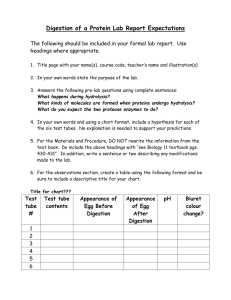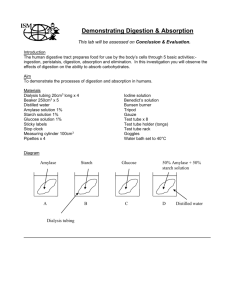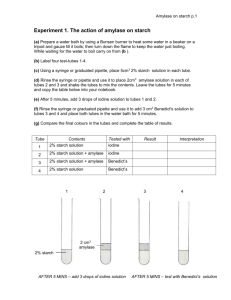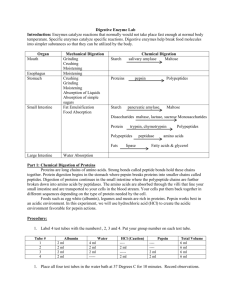Lab 1: Digestion
advertisement
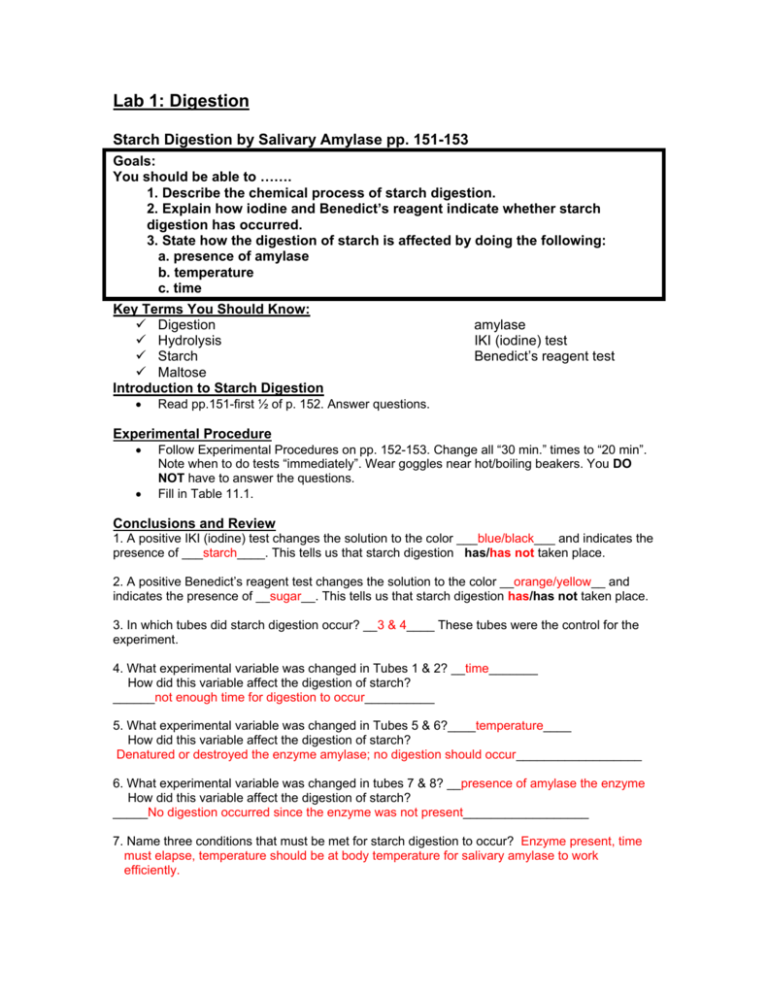
Lab 1: Digestion Starch Digestion by Salivary Amylase pp. 151-153 Goals: You should be able to ……. 1. Describe the chemical process of starch digestion. 2. Explain how iodine and Benedict’s reagent indicate whether starch digestion has occurred. 3. State how the digestion of starch is affected by doing the following: a. presence of amylase b. temperature c. time Key Terms You Should Know: Digestion Hydrolysis Starch Maltose Introduction to Starch Digestion • amylase IKI (iodine) test Benedict’s reagent test Read pp.151-first ½ of p. 152. Answer questions. Experimental Procedure • • Follow Experimental Procedures on pp. 152-153. Change all “30 min.” times to “20 min”. Note when to do tests “immediately”. Wear goggles near hot/boiling beakers. You DO NOT have to answer the questions. Fill in Table 11.1. Conclusions and Review 1. A positive IKI (iodine) test changes the solution to the color ___blue/black___ and indicates the presence of ___starch____. This tells us that starch digestion has/has not taken place. 2. A positive Benedict’s reagent test changes the solution to the color __orange/yellow__ and indicates the presence of __sugar__. This tells us that starch digestion has/has not taken place. 3. In which tubes did starch digestion occur? __3 & 4____ These tubes were the control for the experiment. 4. What experimental variable was changed in Tubes 1 & 2? __time_______ How did this variable affect the digestion of starch? ______not enough time for digestion to occur__________ 5. What experimental variable was changed in Tubes 5 & 6?____temperature____ How did this variable affect the digestion of starch? Denatured or destroyed the enzyme amylase; no digestion should occur__________________ 6. What experimental variable was changed in tubes 7 & 8? __presence of amylase the enzyme How did this variable affect the digestion of starch? _____No digestion occurred since the enzyme was not present__________________ 7. Name three conditions that must be met for starch digestion to occur? Enzyme present, time must elapse, temperature should be at body temperature for salivary amylase to work efficiently. II. Fetal Pig Dissection: External Anatomy, Oral Cavity, & Pharynx GOALS: You should be able to ……………… 1. State characteristics shared by all mammals. 2. Determine whether a pig is male or female. 3. Identify the following structures and state their function(s): Umbilical chord Nipples/mammary glands Urogenital openings (on both male and female) Oral cavity structures: Teeth Tongue Hard palate Soft palate Pharynx structures: Epiglottis Glottis Esophagus trachea Introduction & External Anatomy • Bottom of p. 159 – 161: Read and follow all procedures to locate structures. Wear gloves and goggles! Oral Cavity and Pharynx • P. 162: Read and follow all procedures. Wear goggles and gloves! Use scissors and probes only. • P. 163: Read and follow all procedures #1-3. Review • P. 172: Answer questions #1-5, 9, 10, 18.


